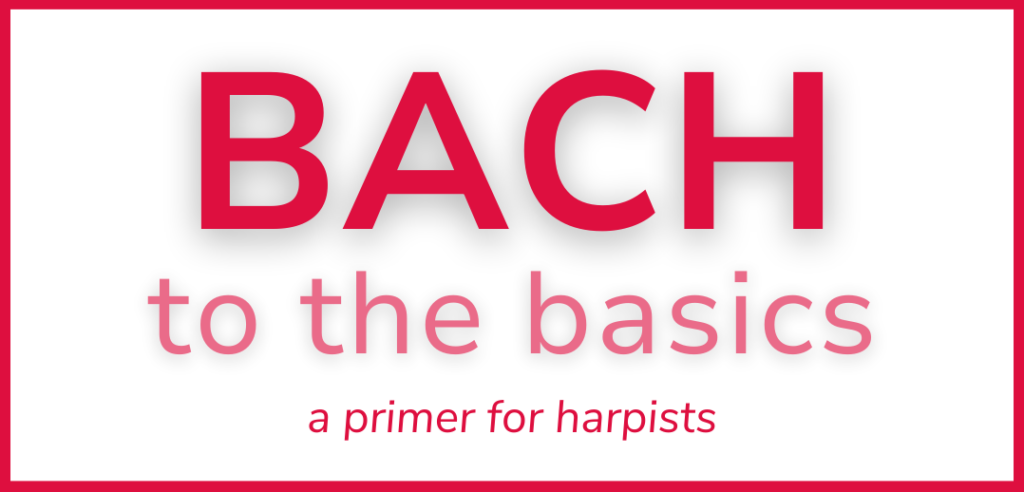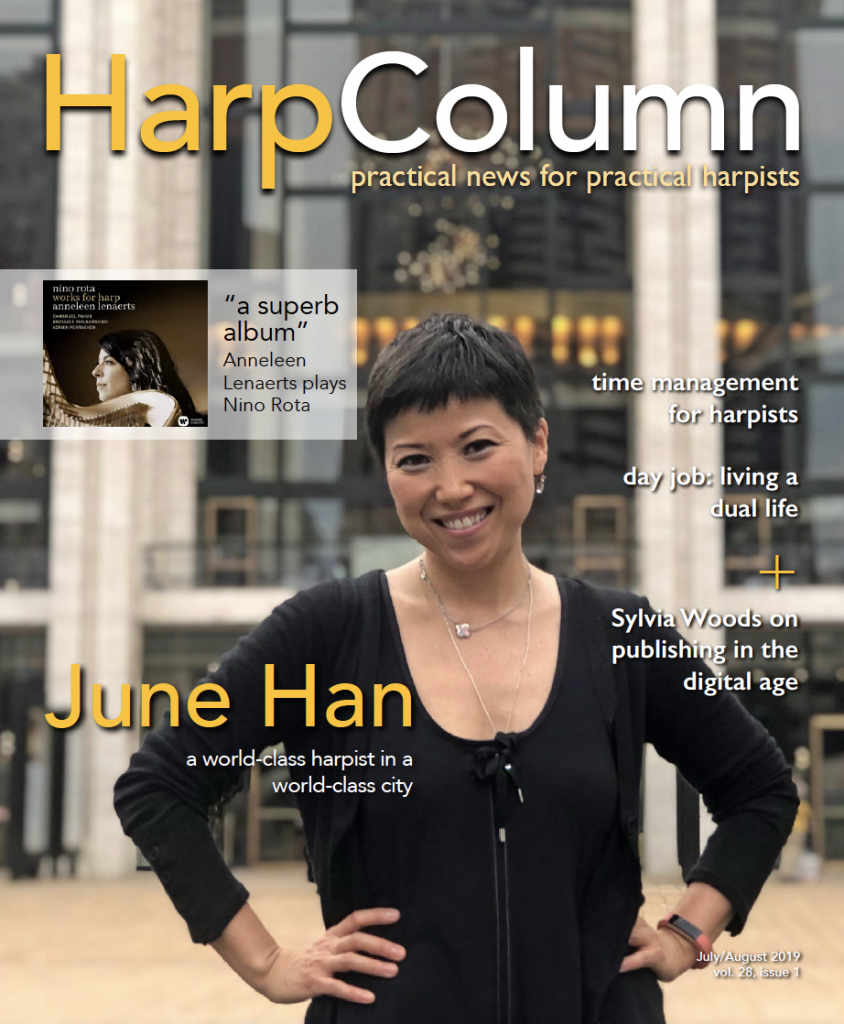“It probably wasn’t so hard for you,” my student said. “You’ve always had to make your own schedule. But for me, when I retired, I found setting my own schedule, and being able to stick to it, surprisingly challenging.”
“Perhaps the biggest hurdle for any working harpist is being the performer, the manager, the roadie, the administrative assistant, and the bookkeeper all rolled into one.”
Her comment made me consider my own professional journey in a new light. From the day I graduated from college, I have been responsible for my own working hours. There’s no 9 to 5 Monday to Friday and weekends off for me, or for any other working musician.
In fact, I only had a “real” job once in my life when as a teenager I worked for six weeks one summer as a clerk at a pharmacy. The rest of my work has been playing music or teaching music. While I consider myself to have been very fortunate in that respect, creating a satisfying a career as a freelance harpist has not been without its challenges.
The first challenge was learning to live with the uncertainty that is part of any freelancer’s life. Not knowing when the next gig will come along, or if there will be enough work in the spring to survive a summer dry spell is stressful. Over time I developed a referral and marketing network that I could trust to keep the proverbial wolf from the door.

Then there were the periodic reflections, the gut-checks that made me wonder if I was on the right path, if carting the harp from job to job was really what I wanted to do as a harpist. The feeling that this isn’t the life you planned for yourself can undermine even the most successful freelance career.
Perhaps the biggest hurdle for any working harpist is being the performer, the manager, the roadie, the administrative assistant, and the bookkeeper all rolled into one. Any one of those roles could be a full-time job, but wearing all the hats requires a high level of organization and discipline.
I once watched a juggler throw a bowling ball, a machete, and a chainsaw. The juggler’s skill and daring were impressive, but thinking about practicing that routine sent a shiver down my spine. One wrong move, one miss could be disastrous.
A miss in a professional harpist’s routine could be almost as serious. A forgotten engagement or a calendar error might result in a damaged reputation with subsequent loss of referrals and income. Smart harpists develop systems and checks to minimize the possibilities of these kinds of slips.
Beneath all the systems, however, lies the real success factor for any professional harpist, or indeed for any harpist at any level of playing. That make-or-break success factor is knowing how to manage time.
Whether you’re trying to fit practice into a busy day, or leave enough time to drive to a gig, or mesh students’ schedules with your own, handling your schedule well is a priority. Learning to balance the daily rush of competing demands and complexities takes planning, patience and practice.
“Choices made in support of your personal priorities and career goals will lead to deep satisfaction; choices made in contrary to your priorities will likely frustrate you.”
I’ve had my own shares of missteps along the way. Fortunately, I started early, so my mistakes weren’t costly. I began playing in youth and community orchestras when I was twelve, which meant that my dad was carting me and my harp all over the Philadelphia area three or four times a week. My parents modeled good organizational skills, particularly in terms of getting where I needed to be on time, so I learned much from them.
My own more detailed organizational systems evolved over time, most often from learning from my mistakes. For instance, after I arrived once at a rehearsal without my tuning key, I learned to always keep spare tuning keys in my harp bag and in the glove compartment of the car. There was the time my single sheets of music were knocked over and went flying at a performance. My music has since always been in a binder.
And after a nerve-racking week of cramming to prepare some Christmas solos that should have been ready well in advance, I learned to create advance deadlines in my practice. As a side note, to get myself through that performance, I wrote myself reminders at the top of each piece to play slowly, and so that I would never forget the lesson I learned, I left those reminders on the page. I see them each year when I pull out that music, and although I no longer need the reminders, my students appreciate seeing the proof of my story.
All of these learning lessons were in my early teenage years, so by the time I got to college, I had some of the basics figured out. I knew how to keep a detailed calendar. I could show up on time and prepared for gigs.
I’m not by nature a person who lives by systems. I love flexibility, spontaneity, and variety. However, I also value structure and organization because they make those other things possible. Having a framework for my practice, for the business side of my harp life, and for my personal life too, creates the space for me to enjoy new opportunities and adventures.
With that in mind, I may not be the best person to enlighten you about systems. Let me introduce you to a real systems ninja harpist, Susan Brady.

I first met Susan when we were both students at the Curtis Institute of Music. She was then, and is now, a harpist who radiates competency. Of course, she’s an excellent harpist, but what is even more impressive about Susan is that she gets things done.
In addition to performing with the Atlanta Opera and the Columbus (Ga.) Symphony Orchestra, Susan teaches at Columbus State University and maintains a private teaching studio with 20 students. Her performance schedule includes frequent chamber music collaborations, solo recitals, and concerto performances.
Susan is also the co-founder and artist faculty of the Young Artist’s Harp Seminar. This two-week summer program is attended by young harpists from all over the world and features a competition every other year. Susan dedicates about eight hours a week all year long just to the Harp Seminar, even though the seminar employs a part-time administrative assistant.
When I spoke with Susan, she told me that although she is now an empty-nester, her biggest career decisions were made when her daughter was only three.
“I was a single mom and knew I had to create a life that incorporated her. It was important to me to make the harp part of her life experience, to include her and later her sister in my world. They were welcome in my studio while I taught or practiced, although they knew that Mom’s work was important. Sometimes the students’ moms would help by giving them a bottle or taking them for a walk while I taught their child.”
Susan would often manage short practice sessions while her daughter was playing in the studio alongside her. She also practiced at night after her children were in bed. “To this day,” she says, “when my daughters come home, they like me to practice in the evening so they can hear my harp music as they fall asleep.”
Her busy schedule necessitates an organized and streamlined practice routine. After a concert experience in Europe when her harp didn’t arrive until the last minute, she learned to reduce her warm-up time to a bare minimum, preferring to warm up with a slow section from one of the pieces she is practicing.
Her best practice advice for the busy harpist is, “Stay one gig ahead.” The music for the performance on her schedule this week was prepared last week. She is practicing this week for the one that is coming up next week. This allows her to avoid last minute cramming and organize her practice time efficiently.
Susan also teaches her students how to plan and manage their time. She helps them develop the professional and personal habits that will make them successful harpists. She is very firm about the need for young professionals to respond to an email or phone call promptly, within 24 hours at the outside. “How you handle the business end of your career actually becomes more important than playing ability. The next generation of harpists needs to be more on top of this.”
Susan’s students experience her organizational mastery first-hand. Every autumn, each student is given an information sheet with every detail clearly outlined: what time to arrive, where to wait, what to bring, where to park, her expectations and of course, her billing policies. “I have a policy for everything,” she says. “This list has evolved over time. This year I had to add a new policy—no acrylic nails!”
Not surprisingly, one of Susan’s former students, Kristi Shade, has become a systems ninja in her own right.

Kristi is the principal harpist with The Chamber Orchestra of New York, a member of the flute-viola-harp trio, Hat Trick, and the harp duo, Duo Scorpio. She is an active freelancer in New York City, and she maintains a flourishing private teaching studio.
While Susan is at the empty nest stage, Kristi is immersed in balancing her harp career and her young family, which includes her husband, 3-year-old son and 8-month-old daughter. “You just make it work,” she says.
For Kristi, making it work means finding a way around the prohibitive cost of childcare in NYC. Currently, she spends each day until 3 p.m. with her children; then it’s teaching until 6 p.m. while her son is at a play program. She sometimes will have a babysitter for her daughter, often trading harp lessons for babysitting help. “This is something I learned from Susan Brady. Trades are good!”
Kristi believes that being a harpist prepared her well for motherhood. “It’s just one more piece of the logistical puzzle. Some people think that if you have kids, you have to stop doing music. I made the decision that your life changes, but it doesn’t change in terms of music. In fact, I’m working more than before. You just do it.”
Kristi built her career by saying “yes” to everything that came her way, but in this stage of her life and career, she has been learning how to say “no.” This means setting boundaries on her work time, turning away new students and limiting her teaching to weekdays. It means being intentional about creating a family life in the midst of the harp hustle.
But what about the brand-new professional just coming out of school and saying “yes” to everything? What does time management look like when you’re intentionally jam-packing your schedule?

I talked with Hope Cowan, a young freelance harpist in Houston. When she finished her master’s degree, Hope worried briefly if she would have enough work to support herself. That proved quickly not to be a concern. She currently performs with several regional orchestras, plays chamber music and solo recitals, and performs for weddings and church events. She plays at the Children’s Hospital, art museums, and the airport. She teaches in an integrated arts education program in the public schools and has over 30 private students.
Hope’s initial plan wasn’t to be a freelance harpist. Originally, her focus was more toward winning an orchestral job and a teaching position at a university. But in her graduate school years, she began teaching more and gigging more to prepare to support herself when she was finished with school. She discovered she loved private teaching and soon saw it as part of a path for herself.
“I love the variety of the work. I feed off the interaction with people both in teaching and performing, with colleagues and with an audience. I meet a lot of people and go to places I otherwise wouldn’t.”
At the same time, she remarks that freelance work is not for everyone. “In school there’s a lot of conversation about what kind of playing you want to do, but not so much about what kind of life you want to have. Do you want a regular paycheck and a regular schedule, or the variety of freelancing?”
Hope allows her schedule to be determined to a large extent by her work. Knowing that her students’ parents are only available on Sundays, for example, she devotes time on Sunday to teaching.
She also feels the lack of regular practice time in her day. She has had to learn to get up earlier to fit in practice time, noting it isn’t the time she’d like, but it’s the only time she has. “People told me when I was in school I wouldn’t have this much practice time again. They were right,” she acknowledges.
Hope is creative in devising safeguards to help her stay on track. She calls it “Hope-proofing” her schedule, tricking herself into doing what she needs to do. For instance, knowing that she naturally tends to run a few minutes late, she always aims to be an hour early for a job, which gets her there a comfortable 45-50 minutes early.
She also sets artificial deadlines for herself to stay on schedule. If she wants to be sure she has a piece ready for performance, she will sometimes make a date with a harpist friend to play through the piece for her. “I’m good if I have a deadline,” she told me, “less good if not.”
What became apparent in my conversations with these harpists is that time management itself is not the issue. There are endless ways to use the amount of time in a day; your choices about how you use that time are the critical factors in your success and happiness. Choices made in support of your personal priorities and career goals will lead to deep satisfaction; choices made contrary to your priorities will likely frustrate you.
I use a five-step framework for aligning my own time choices and my goals. The five steps form an acronym, “IT’S ME.” This is an easy way for me to remind myself that the choices I make about my days and hours are a reflection of what is important to me.
It’s Me
Managing your time well starts with setting your priorities and being intentional about where you spend your time.
Ideal Week
Imagine what your week will look like if it goes as planned. Rough out blocks of time for essential tasks. (Remember, practicing is an essential task for musicians.)
Trim Your Expectations
Unreasonable expectations lead to stress. Consider your commitments and be intentional about what you can realistically accomplish without sacrificing your sanity.
Set up Systems
There are plenty of powerful tools out there to help save you valuable minutes during your day. Find what works for you and use it!
Make Time for Yourself
All work and no play isn’t healthy for anyone and certainly doesn’t feed your creative spirit. Budgeting time for yourself in your schedule is as important as any gig on the books.
Enjoy Where You Are
Planning and priorities are important, but remember your life is happening right now. Do your best to create the musical life you want each day.
IDEAL WEEK
First, start by imagining your ideal week. Taking into account your current commitments and obligations, write down what the perfect week would look like. You don’t have to plan your time down to the minute; just choose large blocks of time and allot them to the activities you want to prioritize.
My ideal week has two hours of practice in the morning each weekday. Monday afternoon is scheduled for writing, correspondence and other computer work. Tuesday, Wednesday, and Thursday afternoons are for teaching. Friday afternoon is a day for appointments and catch-up. On weekends, my ideal practice time is later in the day, and I reserve time for family and friends.
Let me add that this is my ideal week, and that ideal week rarely happens. Performances, rehearsals, and family obligations frequently interfere with this plan. However, it serves as a template for me as I schedule lessons, rehearsals, and meetings, allowing me to shift the time blocks as needed. Plus, I find that the longer I use this template, the closer I get to actually living out my ideal week.
TRIM YOUR EXPECTATIONS
Next, trim your expectations. Even the super-organized harpists can only fit so many things in one day. It is impossible to do everything.
Instead, decide in advance what you will realistically be able to do each day, considering carefully what obligations and commitments must be met, and which items can safely wait for another time. Kristi notes that her to do list often looks overwhelming. “I tell myself, ‘Just do these 10 things today,’ and that makes it more manageable.”
Susan uses a clever sticky note strategy to streamline her practice. When she reads through a piece for the first time, she uses a small sticky note to flag any passage that will need review or practice. Then she can easily find those passages and practice only what needs practice, without practicing the parts of the piece that don’t require extra work.
SET UP SYSTEMS
The third step is to find the systems and tools that will best help you keep track of your schedule, your commitments and your priorities. Susan and Hope use online calendars like Google Calendar which will sync all of their devices and always stay current. Kristi prefers a paper calendar system which allows her to keep notes the way she likes, but she uses iCal to help keep her husband up to date on her schedule.
Susan keeps a record of her students’ lessons and semester payments on a spreadsheet. She tracks her tax-related expenses in her bank’s online app. Kristi bills her students at the beginning of each month and recommends Venmo as a non-confrontational way to ask for payment for gigs and lessons.
I use Google Calendar for my schedule, but I also use a detailed written planner to organize my daily work and track my goals. I find that choosing a few actions each week that tie directly to my goals keeps my work focused in the right direction. Reviewing my goals weekly also keeps me from spending too much time on activities that won’t lead to the results I want.
It’s important to remember that as helpful as technology can be, it can be a trap too. I make it a rule never to take my phone into my practice studio with me. It’s worth the cost of a metronome to save myself from the temptation of a quick peek at my email or social media.
MAKE TIME FOR YOURSELF
Fourth, all the harpists agreed that building time for yourself into your schedule is critical. Hope makes sure she takes well-deserved and needed vacation time by buying non-refundable tickets. Kristi’s advice is to “Always have time for yourself, whatever that means to you, time for practicing or for reading. At a certain point you have to let it go.”
Susan loves to sew and quilt. Her sewing allows her to keep her hands busy, to relieve stress, and to refresh her mind away from music. “My sewing room is right next to my harp room, and I will often go back and forth—30 minutes of harp and 30 minutes of sewing. The sewing keeps me grounded, and there’s no tension involved.”
ENJOY WHERE YOU ARE NOW
The last and most vital step in managing yourself, your time, and your priorities is to remember to enjoy where you are now. Wherever you are in your harp journey at this moment, you will not be there forever. The seasons of life change. Don’t wait to enjoy your life; create the life you want each day.
Hope believes that for young harpists, the key is being alive to new opportunities. “Stay open-minded, do as much as you can, and see where it leads you.”
For Kristi, success comes from being intentional about creating a life in the midst of the chaos and remaining connected to the things that matter most. “Keep that passion project that keeps you going. It pulls you back to remind you of what you love and keeps you grounded.”
Author John C. Maxwell writes, “Time management is an oxymoron. Time is beyond our control, and the clock keeps ticking regardless of how we lead our lives. Priority management is the answer to maximizing the time we have.” Knowing your direction, your goals, your dreams is where time management starts. From there, you simply take the next step in the right direction. •

















